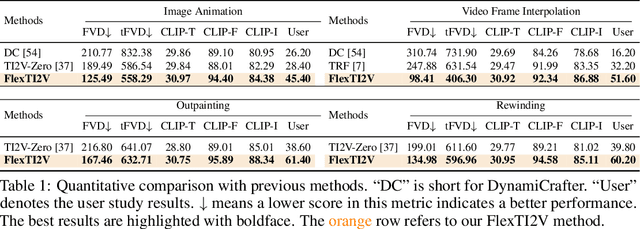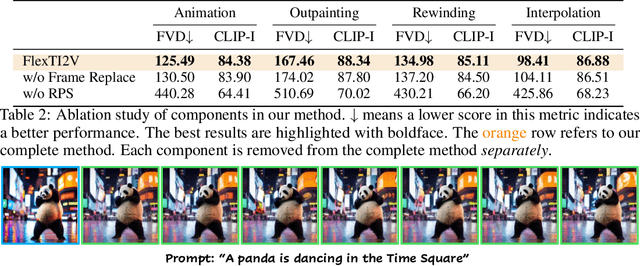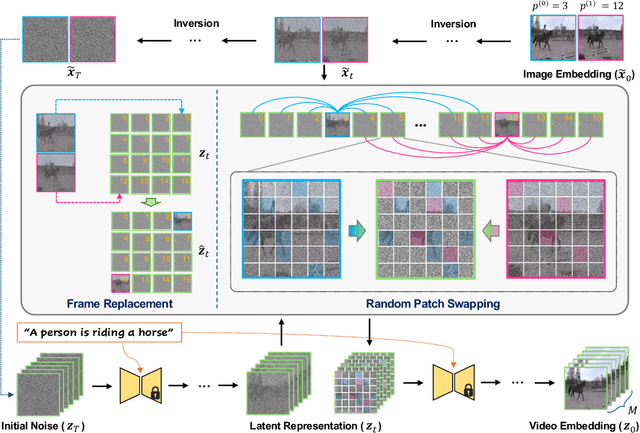James M. Rehg
Improving Personalized Search with Regularized Low-Rank Parameter Updates
Jun 11, 2025Abstract:Personalized vision-language retrieval seeks to recognize new concepts (e.g. "my dog Fido") from only a few examples. This task is challenging because it requires not only learning a new concept from a few images, but also integrating the personal and general knowledge together to recognize the concept in different contexts. In this paper, we show how to effectively adapt the internal representation of a vision-language dual encoder model for personalized vision-language retrieval. We find that regularized low-rank adaption of a small set of parameters in the language encoder's final layer serves as a highly effective alternative to textual inversion for recognizing the personal concept while preserving general knowledge. Additionally, we explore strategies for combining parameters of multiple learned personal concepts, finding that parameter addition is effective. To evaluate how well general knowledge is preserved in a finetuned representation, we introduce a metric that measures image retrieval accuracy based on captions generated by a vision language model (VLM). Our approach achieves state-of-the-art accuracy on two benchmarks for personalized image retrieval with natural language queries - DeepFashion2 and ConCon-Chi - outperforming the prior art by 4%-22% on personal retrievals.
LSM-2: Learning from Incomplete Wearable Sensor Data
Jun 05, 2025Abstract:Foundation models, a cornerstone of recent advancements in machine learning, have predominantly thrived on complete and well-structured data. Wearable sensor data frequently suffers from significant missingness, posing a substantial challenge for self-supervised learning (SSL) models that typically assume complete data inputs. This paper introduces the second generation of Large Sensor Model (LSM-2) with Adaptive and Inherited Masking (AIM), a novel SSL approach that learns robust representations directly from incomplete data without requiring explicit imputation. AIM's core novelty lies in its use of learnable mask tokens to model both existing ("inherited") and artificially introduced missingness, enabling it to robustly handle fragmented real-world data during inference. Pre-trained on an extensive dataset of 40M hours of day-long multimodal sensor data, our LSM-2 with AIM achieves the best performance across a diverse range of tasks, including classification, regression and generative modeling. Furthermore, LSM-2 with AIM exhibits superior scaling performance, and critically, maintains high performance even under targeted missingness scenarios, reflecting clinically coherent patterns, such as the diagnostic value of nighttime biosignals for hypertension prediction. This makes AIM a more reliable choice for real-world wearable data applications.
Incorporating Flexible Image Conditioning into Text-to-Video Diffusion Models without Training
May 27, 2025



Abstract:Text-image-to-video (TI2V) generation is a critical problem for controllable video generation using both semantic and visual conditions. Most existing methods typically add visual conditions to text-to-video (T2V) foundation models by finetuning, which is costly in resources and only limited to a few predefined conditioning settings. To tackle this issue, we introduce a unified formulation for TI2V generation with flexible visual conditioning. Furthermore, we propose an innovative training-free approach, dubbed FlexTI2V, that can condition T2V foundation models on an arbitrary amount of images at arbitrary positions. Specifically, we firstly invert the condition images to noisy representation in a latent space. Then, in the denoising process of T2V models, our method uses a novel random patch swapping strategy to incorporate visual features into video representations through local image patches. To balance creativity and fidelity, we use a dynamic control mechanism to adjust the strength of visual conditioning to each video frame. Extensive experiments validate that our method surpasses previous training-free image conditioning methods by a notable margin. We also show more insights of our method by detailed ablation study and analysis.
MEBench: A Novel Benchmark for Understanding Mutual Exclusivity Bias in Vision-Language Models
May 26, 2025Abstract:This paper introduces MEBench, a novel benchmark for evaluating mutual exclusivity (ME) bias, a cognitive phenomenon observed in children during word learning. Unlike traditional ME tasks, MEBench further incorporates spatial reasoning to create more challenging and realistic evaluation settings. We assess the performance of state-of-the-art vision-language models (VLMs) on this benchmark using novel evaluation metrics that capture key aspects of ME-based reasoning. To facilitate controlled experimentation, we also present a flexible and scalable data generation pipeline that supports the construction of diverse annotated scenes.
ShotAdapter: Text-to-Multi-Shot Video Generation with Diffusion Models
May 12, 2025Abstract:Current diffusion-based text-to-video methods are limited to producing short video clips of a single shot and lack the capability to generate multi-shot videos with discrete transitions where the same character performs distinct activities across the same or different backgrounds. To address this limitation we propose a framework that includes a dataset collection pipeline and architectural extensions to video diffusion models to enable text-to-multi-shot video generation. Our approach enables generation of multi-shot videos as a single video with full attention across all frames of all shots, ensuring character and background consistency, and allows users to control the number, duration, and content of shots through shot-specific conditioning. This is achieved by incorporating a transition token into the text-to-video model to control at which frames a new shot begins and a local attention masking strategy which controls the transition token's effect and allows shot-specific prompting. To obtain training data we propose a novel data collection pipeline to construct a multi-shot video dataset from existing single-shot video datasets. Extensive experiments demonstrate that fine-tuning a pre-trained text-to-video model for a few thousand iterations is enough for the model to subsequently be able to generate multi-shot videos with shot-specific control, outperforming the baselines. You can find more details in https://shotadapter.github.io/
SocialGesture: Delving into Multi-person Gesture Understanding
Apr 03, 2025Abstract:Previous research in human gesture recognition has largely overlooked multi-person interactions, which are crucial for understanding the social context of naturally occurring gestures. This limitation in existing datasets presents a significant challenge in aligning human gestures with other modalities like language and speech. To address this issue, we introduce SocialGesture, the first large-scale dataset specifically designed for multi-person gesture analysis. SocialGesture features a diverse range of natural scenarios and supports multiple gesture analysis tasks, including video-based recognition and temporal localization, providing a valuable resource for advancing the study of gesture during complex social interactions. Furthermore, we propose a novel visual question answering (VQA) task to benchmark vision language models'(VLMs) performance on social gesture understanding. Our findings highlight several limitations of current gesture recognition models, offering insights into future directions for improvement in this field. SocialGesture is available at huggingface.co/datasets/IrohXu/SocialGesture.
Learning Predictive Visuomotor Coordination
Mar 30, 2025Abstract:Understanding and predicting human visuomotor coordination is crucial for applications in robotics, human-computer interaction, and assistive technologies. This work introduces a forecasting-based task for visuomotor modeling, where the goal is to predict head pose, gaze, and upper-body motion from egocentric visual and kinematic observations. We propose a \textit{Visuomotor Coordination Representation} (VCR) that learns structured temporal dependencies across these multimodal signals. We extend a diffusion-based motion modeling framework that integrates egocentric vision and kinematic sequences, enabling temporally coherent and accurate visuomotor predictions. Our approach is evaluated on the large-scale EgoExo4D dataset, demonstrating strong generalization across diverse real-world activities. Our results highlight the importance of multimodal integration in understanding visuomotor coordination, contributing to research in visuomotor learning and human behavior modeling.
Towards Online Multi-Modal Social Interaction Understanding
Mar 25, 2025Abstract:Multimodal social interaction understanding (MMSI) is critical in human-robot interaction systems. In real-world scenarios, AI agents are required to provide real-time feedback. However, existing models often depend on both past and future contexts, which hinders them from applying to real-world problems. To bridge this gap, we propose an online MMSI setting, where the model must resolve MMSI tasks using only historical information, such as recorded dialogues and video streams. To address the challenges of missing the useful future context, we develop a novel framework, named Online-MMSI-VLM, that leverages two complementary strategies: multi-party conversation forecasting and social-aware visual prompting with multi-modal large language models. First, to enrich linguistic context, the multi-party conversation forecasting simulates potential future utterances in a coarse-to-fine manner, anticipating upcoming speaker turns and then generating fine-grained conversational details. Second, to effectively incorporate visual social cues like gaze and gesture, social-aware visual prompting highlights the social dynamics in video with bounding boxes and body keypoints for each person and frame. Extensive experiments on three tasks and two datasets demonstrate that our method achieves state-of-the-art performance and significantly outperforms baseline models, indicating its effectiveness on Online-MMSI. The code and pre-trained models will be publicly released at: https://github.com/Sampson-Lee/OnlineMMSI.
Pulse-PPG: An Open-Source Field-Trained PPG Foundation Model for Wearable Applications Across Lab and Field Settings
Feb 03, 2025Abstract:Photoplethysmography (PPG)-based foundation models are gaining traction due to the widespread use of PPG in biosignal monitoring and their potential to generalize across diverse health applications. In this paper, we introduce Pulse-PPG, the first open-source PPG foundation model trained exclusively on raw PPG data collected over a 100-day field study with 120 participants. Existing PPG foundation models are either open-source but trained on clinical data or closed-source, limiting their applicability in real-world settings. We evaluate Pulse-PPG across multiple datasets and downstream tasks, comparing its performance against a state-of-the-art foundation model trained on clinical data. Our results demonstrate that Pulse-PPG, trained on uncurated field data, exhibits superior generalization across clinical and mobile health applications in both lab and field settings. This suggests that exposure to real-world variability enables the model to learn fine-grained representations, making it more adaptable across tasks. Furthermore, pre-training on field data surprisingly outperforms its pre-training on clinical data in many tasks, reinforcing the importance of training on real-world, diverse datasets. To encourage further advancements in robust foundation models leveraging field data, we plan to release Pulse-PPG, providing researchers with a powerful resource for developing more generalizable PPG-based models.
SPAR3D: Stable Point-Aware Reconstruction of 3D Objects from Single Images
Jan 08, 2025



Abstract:We study the problem of single-image 3D object reconstruction. Recent works have diverged into two directions: regression-based modeling and generative modeling. Regression methods efficiently infer visible surfaces, but struggle with occluded regions. Generative methods handle uncertain regions better by modeling distributions, but are computationally expensive and the generation is often misaligned with visible surfaces. In this paper, we present SPAR3D, a novel two-stage approach aiming to take the best of both directions. The first stage of SPAR3D generates sparse 3D point clouds using a lightweight point diffusion model, which has a fast sampling speed. The second stage uses both the sampled point cloud and the input image to create highly detailed meshes. Our two-stage design enables probabilistic modeling of the ill-posed single-image 3D task while maintaining high computational efficiency and great output fidelity. Using point clouds as an intermediate representation further allows for interactive user edits. Evaluated on diverse datasets, SPAR3D demonstrates superior performance over previous state-of-the-art methods, at an inference speed of 0.7 seconds. Project page with code and model: https://spar3d.github.io
 Add to Chrome
Add to Chrome Add to Firefox
Add to Firefox Add to Edge
Add to Edge